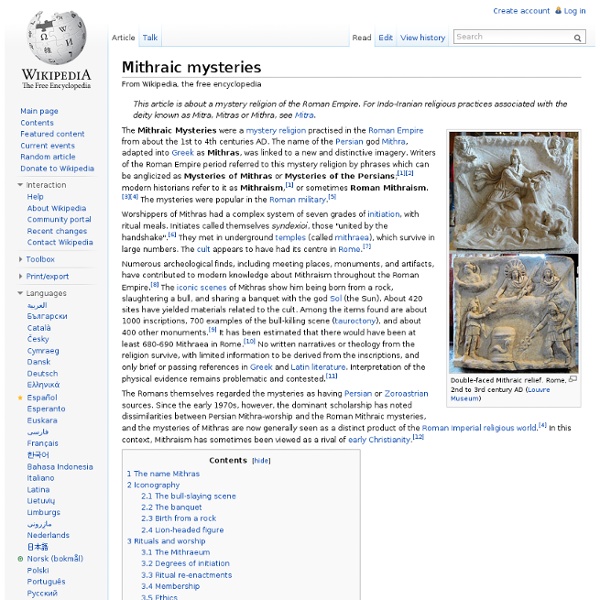Eleusinian Mysteries
Votive plaque depicting elements of the Eleusinian Mysteries, discovered in the sanctuary at Eleusis (mid-4th century BC) The rites, ceremonies, and beliefs were kept secret and consistently preserved from a hoary antiquity. The initiated believed that they would have a reward in the afterlife.[5] There are many paintings and pieces of pottery that depict various aspects of the Mysteries. Mythology of Demeter and Persephone[edit] The Mysteries are related to a myth concerning Demeter, the goddess of agriculture and fertility as recounted in one of the Homeric Hymns (c. 650 BC). According to the myth, during her search Demeter traveled long distances and had many minor adventures along the way. Zeus, pressed by the cries of the hungry people and by the other deities who also heard their anguish, forced Hades to return Persephone. Her rebirth is symbolic of the rebirth of all plant life and the symbol of eternity of life that flows from the generations that spring from each other.[12]
Dionysian Mysteries
The Dionysian Mysteries were a ritual of ancient Greece and Rome which used intoxicants and other trance-inducing techniques (like dance and music) to remove inhibitions and social constraints, liberating the individual to return to a natural state. It also provided some liberation for those marginalized by Greek society: women, slaves and foreigners. In their final phase the Mysteries shifted their emphasis from a chthonic, underworld orientation to a transcendental, mystical one, with Dionysus changing his nature accordingly (similar to the change in the cult of Shiva). By its nature as a mystery religion reserved for the initiated, many aspects of the Dionysian cult remain unknown and were lost with the decline of Greco-Roman polytheism; our knowledge is derived from descriptions, imagery and cross-cultural studies. Origins[edit] Early Dionysus cult[edit] Role of wine[edit] Rites[edit] Emergence and evolution[edit] Male initiation rituals[edit] Female initiation rituals[edit]
Bohemianism
This use of the word bohemian first appeared in the English language in the nineteenth century[1] to describe the non-traditional lifestyles of marginalized and impoverished artists, writers, journalists, musicians, and actors in major European cities. Bohemians were associated with unorthodox or anti-establishment political or social viewpoints, which often were expressed through free love, frugality, and—in some cases—voluntary poverty. A wealthy and privileged, even aristocratic, bohemian circle is sometimes referred to as the haute bohème[2] ("high bohemians").[3] The term Bohemianism emerged in France in the early nineteenth century when artists and creators began to concentrate in the lower-rent, lower class, gypsy neighborhoods. Origins[edit] European bohemianism[edit] The term Bohemian has come to be very commonly accepted in our day as the description of a certain kind of literary gypsy, no matter in what language he speaks, or what city he inhabits .... People[edit] Europe Canada
Free love
Free love is a social movement that rejects marriage, which is seen as a form of social and financial bondage. The Free Love movement's initial goal was to separate the state from sexual matters such as marriage, birth control, and adultery. It claimed that such issues were the concern of the people involved, and no one else.[1] Many people believe marriage is an important aspect of life to "fulfil earthly human happiness." While the phrase free love is often associated with promiscuity in the popular imagination, especially in reference to the counterculture of the 1960s and 1970s, historically the free-love movement has not advocated multiple sexual partners or short-term sexual relationships. The term "sex radical" is also used interchangeably with the term "free lover", and was the preferred term by advocates because of the negative connotations of "free love". The women's movement[edit] The history of free love is entwined with the history of feminism. In the 1850s, Hannah R.
Brethren of the Free Spirit
The Brothers, or Brethren of the Free Spirit, was a lay Christian movement which flourished in northern Europe in the 13th and 14th centuries. Antinomian and individualist in outlook, it came into conflict with the Catholic Church and was declared heretical by Pope Clement V at the Council of Vienne (1311–12). They are often considered similar to the Amalricians. They flourished at a time of great trauma in Western Europe during the conflict between the Avignon Papacy and the Holy Roman Emperor, the Hundred Years' War, the Black Death, the rise of the Cathar heresy and the subsequent Crusade against them, the beginnings of the Inquisition, the fall of the Templars and the internal strife of the Church — all of which helped fuel the appeal of their individualistic and millenarian approach to Christianity and Scripture. History[edit] From the very beginning of what would become the Free Spirit Heresy its followers ran into trouble with the secular and religious authorities. Doctrine[edit]
Inquisition
The Inquisition was a group of institutions within the judicial system of the Roman Catholic Church whose aim was to combat heresy. It started in 12th-century France to combat the spread of religious sectarianism, in particular the Cathars and the Waldensians. This Medieval Inquisition persisted into the 14th century, and from the 1250s was associated with the Dominican Order. In the early 14th century, two other movements attracted the attention of the Inquisition, the Knights Templar and the Beguines. The institution of the Inquisition persisted after the end of the witch-trial period in the 18th century, but in the Age of Reason was abolished outside of the Papal States after the Napoleonic wars of the early 19th century. The institution survives as part of the Roman Curia, renamed to Supreme Sacred Congregation of the Holy Office in 1904. Definition and purpose[edit] Historical background[edit] Medieval Inquisition[edit] Early Modern history[edit] Emblem of the Inquisition (1571)



